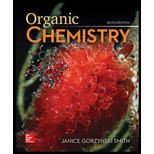
Concept explainers
(a)
Interpretation: The product formed by the thermal electrocyclic ring closure of given triene N is to be determined.
Concept introduction: Electrocyclic reactions are pericyclic reactions which takes place by concerted mechanism. These reactions involve ring opening or ring closure in a conjugated polyene.
(b)
Interpretation: The product formed by the photochemical electrocyclic ring closure of given triene N is to be determined.
Concept introduction: Electrocyclic reactions are pericyclic reactions which takes place by concerted mechanism. These reactions involve ring opening or ring closure in a conjugated polyene.
(c)
Interpretation: The given processes are to be labeled as conrotatory or disrotatory.
Concept introduction: Electrocyclic reactions are pericyclic reactions which takes place by concerted mechanism. These reactions involve ring opening or ring closure in a conjugated polyene. In Conratotory process, the orbitals where rearrangement is taking place rotates in clockwise direction and in disrotatory process the atomic orbitals rotates in opposite direction.
Want to see the full answer?
Check out a sample textbook solution
Chapter 25 Solutions
ORGANIC CHEMISTRY (LOOSELEAF)
- The endiandric acids comprise a group of unsaturated carboxylic acids isolated from a tree that grows in the rainforests of eastern Australia. The methyl esters of endiandric acids D and E have been prepared from polyene Y by a series of two successive electrocyclic reactions: thermal ring closure of the conjugated tetraene followed by ring closure of the resulting conjugated triene. (a) Draw the structures (including stereochemistry) of the methyl esters of endiandric acids D and E. (b) The methyl ester of endiandric acid E undergoes an intramolecular [4 + 2] cycloaddition to form the methyl ester of endiandric acid A. Propose a possible structure for endiandric acid A.arrow_forwardThe endiandric acids comprise a group of unsaturated carboxylic acids isolated from a tree that grows in the rain forests of eastern Australia. The methyl esters of endiandric acids D and E have been prepared from polyene Y by a series of two successive electrocyclic reactions: thermal ring closure of the conjugated tetraene followed by ring closure of the resultingconjugated triene. (a) Draw the structures (including stereochemistry) of the methyl esters of endiandric acids D and E. (b) The methyl ester of endiandric acid E undergoes an intramolecular [4 + 2] cycloaddition to form the methyl ester of endiandric acid A. Propose a possible structure for endiandric acid A.arrow_forward(a) Give an acceptable name for compound A. (b) Draw the organic products formed when A is treated with each reagent: [1] H3O+; [2] −OH, H2O; [3] CH3CH2CH2MgBr (excess), then H2O; [4] LiAlH4, then H2O.arrow_forward
- For alkenes A, B, and C: (a) Rank A, B, and C in order of increasing heat of hydrogenation; (b) rank A, B, and C in order of increasing rate of reaction with H2, Pd-C; (c) draw the products formed when each alkene is treated with ozone, followed by Zn, H2O.arrow_forwardDraw the product formed when each triene undergoes electrocyclic reaction under [1] thermal conditions; [2] photochemical conditions.arrow_forwardFor alkenes A, B, C, and D: (a) Rank A—D in order of increasing heat of hydrogenation; (b) rank A—D in order of increasing rate of reaction with H2, Pd-C; (c) draw the products formed when each alkene is treated with ozone, followed by Zn, H2O.arrow_forward
- (a) (b) HO N N-H Catalytic H+ (-H₂O) ? (c) NH2 HO N (d)arrow_forward(a) What alkene yields A and B when it is treated with Br2 in CCl4? (b) What alkene yields C and D under the same conditions?arrow_forwardCompound W has molecular formula C₁4H18 and reacts with H₂ to form X. Oxidative cleavage of W with O3 followed by CH3 SCH3 affords Y. What is the structure of W?arrow_forward
 ChemistryChemistryISBN:9781305957404Author:Steven S. Zumdahl, Susan A. Zumdahl, Donald J. DeCostePublisher:Cengage Learning
ChemistryChemistryISBN:9781305957404Author:Steven S. Zumdahl, Susan A. Zumdahl, Donald J. DeCostePublisher:Cengage Learning ChemistryChemistryISBN:9781259911156Author:Raymond Chang Dr., Jason Overby ProfessorPublisher:McGraw-Hill Education
ChemistryChemistryISBN:9781259911156Author:Raymond Chang Dr., Jason Overby ProfessorPublisher:McGraw-Hill Education Principles of Instrumental AnalysisChemistryISBN:9781305577213Author:Douglas A. Skoog, F. James Holler, Stanley R. CrouchPublisher:Cengage Learning
Principles of Instrumental AnalysisChemistryISBN:9781305577213Author:Douglas A. Skoog, F. James Holler, Stanley R. CrouchPublisher:Cengage Learning Organic ChemistryChemistryISBN:9780078021558Author:Janice Gorzynski Smith Dr.Publisher:McGraw-Hill Education
Organic ChemistryChemistryISBN:9780078021558Author:Janice Gorzynski Smith Dr.Publisher:McGraw-Hill Education Chemistry: Principles and ReactionsChemistryISBN:9781305079373Author:William L. Masterton, Cecile N. HurleyPublisher:Cengage Learning
Chemistry: Principles and ReactionsChemistryISBN:9781305079373Author:William L. Masterton, Cecile N. HurleyPublisher:Cengage Learning Elementary Principles of Chemical Processes, Bind...ChemistryISBN:9781118431221Author:Richard M. Felder, Ronald W. Rousseau, Lisa G. BullardPublisher:WILEY
Elementary Principles of Chemical Processes, Bind...ChemistryISBN:9781118431221Author:Richard M. Felder, Ronald W. Rousseau, Lisa G. BullardPublisher:WILEY





